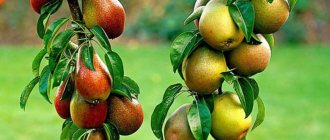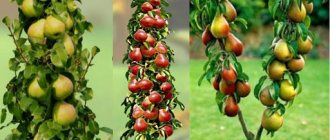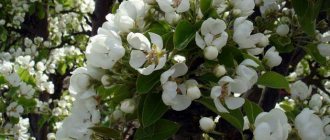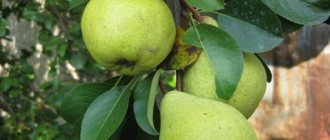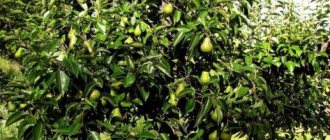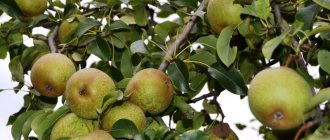Pear Vidnaya.
Description of the variety
Vidnaya pear is a late-summer ripening variety. Another name for this variety is Lumpy. In 1972, it was included among the elite varieties. Vidnaya is most often found in gardens in the Moscow region.
Characteristics of wood
Pear variety Vidnaya.
The trees are vigorous and reach a height of 5-6 meters. At a young age, the crown is spreading, but over the years it acquires a pyramidal shape.
The crown density is average. The bark on the shoots is light brown. The leaves are small, bright green. The leaf plate is smooth.
Description of fruits
The average weight of one pear is about 150 grams. The fruits are oblong in shape, with pronounced ribbing. At the stage of consumer ripeness, the surface of the pear has an attractive amber hue.
An orange blush appears slightly on the sunny side of the fruit. The taste is pleasant, sweet and sour.
Fruit ripening occurs unevenly. Harvesting occurs from the last ten days of August to the second ten days of September. The fruits hold tightly to the tree and do not fall off. The shelf life of the harvested crop does not exceed 7 days.
Pear Vidnaya.
Harvesting
This variety has medium early fruiting. The harvest appears in 4–5 years. From one pear you can remove from 40 to 60 kg of fruit.
The first pear harvest will appear 4–5 years after planting
Ripening occurs in the third ten days of August. The fruits ripen in stages, so harvesting should be done as they ripen, usually 2-3 times. Only ripened pears are harvested, since Vidnaya does not ripen outside the tree - the pulp becomes tasteless and mealy.
Pears are harvested in dry weather
Pear picking should be done in the morning or evening, in dry weather. The fruits are placed in wicker baskets or boxes. You need to handle the pear carefully; even the thick skin can be accidentally damaged. Whole fruits do not last long - at room temperature for 2-3 days, in the refrigerator - 1 week.
Various dishes can be prepared from the Vidnaya harvest
These fruits make wonderful canned products: jams, pastilles, confiture, marmalade, compotes.
Reviews
Svetlana
Eagle
The tree is very productive. Every year it bears fruit so abundantly that the branches bend under the weight. Pears are very tasty, large, but once removed from the tree they spoil very quickly. This is especially true for those that have been bitten by insects or birds; they simply rot before our eyes.
Natalia
Vladimirov
Delicious pears Visible like honey. But insects love them very much, so you have to constantly monitor this. The fruits are quickly processed because they disappear immediately after being picked. Otherwise there are no complaints.
Irina
Lipetsk
This pear has been growing at our dacha for a long time. The tree is very tall and harvesting from it is not so easy. The fruits are very beautiful, large and their taste is simply excellent.
How to protect Vidnaya pear from damage
This pear variety is resistant to powdery mildew and scab, but can be susceptible to other diseases.
Table: possible pests and diseases of pear
| Problems | How do they manifest themselves? | Prevention measures | Control measures |
| Moniliosis | The leaves dry out, and if the attack is severe, the tree looks scorched. The fruits are covered with dark spots of rot. The flesh darkens |
|
|
| Rust | Reddish-brown spots appear on the leaf blades. Then their color changes, becoming brighter. On the reverse side, the leaves are covered with a fleecy coating of an orange hue. |
| |
| Bacterial burn | The buds cannot fully bloom and fall off. Leaves darken and curl |
| |
| Aphid | Small green or brown insects form entire colonies on the undersides of leaves. They feed on the sap of the plant and weaken it |
| |
| codling moth | The insect eats the seeds in the fruits, leaving its secretions in the pulp. Pears become inedible |
| |
| leaf roller | The insect eats away the entire leaf, leaving only veins |
|
How to recognize diseases and pests: examples in the photo
Moniliosis makes fruits inedible
The codling moth eats the middle of the fruit
When a bacterial burn occurs, the leaves darken and curl.
Rust can be easily identified by bright spots on the leaves.
Aphids form colonies on shoots and leaves, sucking juices from the plant
The leaf roller can be easily identified by the curled leaves
Landing
The Vidnaya variety easily adapts to different conditions and is able to bear fruit well on infertile soil. To familiarize yourself with recommendations for choosing a site and preparing a planting hole, you must follow the links below.
How to plant a pear tree correctly
At what distance to plant pears?
How to choose pear seedlings
How to replant a pear
Features of agricultural technology
To grow a healthy plant that will produce a stable harvest, you need to follow the rules of its cultivation.
Optimal timing
In the southern regions, Vidnaya pear is recommended to be planted at the end of September or early October. Over the winter, the seedling will have time to grow stronger and take root. With the arrival of spring and warmth, the tree will begin to grow.
In regions with an unstable and cold climate, it is better to plant this pear variety in the spring, in the second half of April. By this time, the soil will have time to warm up and become saturated with melt water. But planting must be done quickly, before the young plant’s buds swell.
Site selection
For the Vidnaya pear variety, you should choose a sunny and spacious area in the garden. If you plant a tree in the shade, its fruits will be tasteless and the yield will decrease several times. It is advisable that there is a fence on the north side of the plant that will protect it from cold winds.
Pear does not tolerate stagnant water and wetlands. In low-lying areas, you need to make drainage or plant the seedling on a slight hill. Groundwater should not be closer than 2 m from the surface.
Vidnaya is undemanding to the soil, but feels more comfortable on sandy loam, chernozem and slightly acidic soils.
Attention! To reduce the acidity of the soil, lime is added to it at the rate of 3.5 kg/10 m2.
Preparing the planting hole
Site preparation should begin six months before planting Vidnaya. To do this, it is recommended to adhere to the following rules:
- The planting hole for a pear seedling should be spacious, 90-100 cm deep and at least 80 cm in diameter.
- The top fertile layer of soil, 20 cm thick, must be set aside separately. 25-30 kg of rotted manure or compost, 1 kg of superphosphate, 80 g of potassium nitrate and 0.8 - 1 kg of wood ash are added to it.
- The soil mixture is thoroughly mixed and poured into the hole. A small hill should form.
Some gardeners recommend covering the hole with film.
Landing rules
The process of planting the Vidnaya pear:
- Soak the roots of the plant in any biostimulant or in a 3% solution of potassium permanganate for a day. Then treat them with a mixture of clay and mullein and leave to dry for 2 hours.
- Drive a stick into the center of the hole, which should be 1.5 times higher than the seedling. It will serve as a support.
- Straighten the roots of the seedling and lower it into the hole. The root neck of the tree should be 7-8 cm above the ground surface.
- Cover the plant with soil, compact the soil and tie the seedling to a support.
- Form a groove around the tree at a distance of 0.5 meters from the trunk.
- Water the pear with 30-40 liters of warm water.
To preserve moisture, the tree trunk circle is mulched with compost or sawdust.
Care
Pear care plays an important role for the further development of the plant, especially in the first years after planting. In the articles selected below, you can familiarize yourself with useful materials on the topic of growing the Vidnaya variety.
How to care for a pear Pruning a pear Pruning a columnar pear Treating a pear from diseases and pests Feeding a pear How to water a pear
History of selection
As a result of breeding work in 1958 in Moscow, by crossing the hybrid form 53-67 with a mixture of pollen from southern varieties, the Vidnaya or Lumpy pear was obtained. The authors of this species are Yu. A. Petrov and N. V. Efimov. The culture is intended for cultivation in the Central region; it is popular in the Moscow region, the middle zone, and in many countries of Asia and Europe.
What regions is the variety adapted to?
The Vidnaya pear variety is zoned in the Central region. Pears are often planted in the Moscow region and neighboring areas.
Diseases and pests
Trees of this variety are highly resistant to scab and powdery mildew. To protect the plant from other diseases and harmful insects, preventive spraying should be carried out regularly.
Information on how, when and with what drugs to treat and protect Vidnaya is found in the selection of articles below.
Dangerous Pear Pests
Pears often suffer from pests, they affect the leaves, bark and fruits.
In this article, we have selected 11 of the most harmful insects that harm pear trees, and also ways to destroy them.
Diseases of pear trees
To get what they cherish, gardeners have to work hard, and the reason for this is pear diseases.
Read about 19 common pear diseases and how to combat them.
Advantages and disadvantages
The Vidnaya pear variety has a number of positive qualities that distinguish it from other subspecies. They are:
- Early fruiting, the first ripened harvest can be obtained after three to four years of life.
- High level of cold resistance.
- High level of immunity to diseases such as powdery mildew and scab.
- Constant and abundant harvest.
- The buds are not affected during frosts, since this variety has a late flowering period.
- It is not a capricious crop at all, which can grow even on poor soil.
- Self-fertile variety.
- High level of taste and product characteristics.
Due to the fact that the Vidnaya or Lumpy pear has so many positive qualities, the subspecies is often grown not only in private gardening, but also on an industrial scale. This variety is also often used for breeding purposes.
The Vidnaya pear variety has virtually no disadvantages. When fresh, the fruit can have a shelf life of a maximum of 8-9 days. Pears ripen unevenly, making it better to harvest in several stages. And due to the fact that the tree is distinguished by its spreading nature and height, some fruits are quite difficult to reach.
Although the variety is considered self-fertile, it is worth planting a pollinator tree, such as Osennaya Yakovleva or Rogneda, near this tree. Due to this, your variety will give you even larger fruits and a bountiful harvest.
What gardeners say
Reviews:
Yri , Bryansk region Trubchevsk
As if summing up the conversation about the Vidnaya variety and after tasting the fruits - my subjective opinion. The variety really has an average taste, somewhere between 3.9 and 4.1 points. However, one of the noticeable advantages is that the pear surprisingly does not become boring. Those. I ate one, it seems so-so, but my hand reaches for the other and the unevenness of ripening here somehow helps not to eat everything at once.
Another positive point is that the seed chambers are very small and, sorry, the core remains in the form of a thin thread. Those. practically absent. From Epsent.

